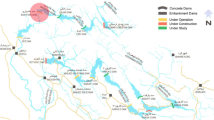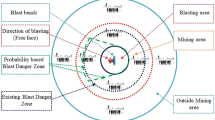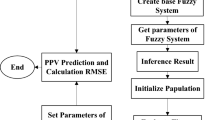Abstract
Rock blasting is a well-known and common method for the removal of rock masses from an excavation in surface mines and civil projects. Ground vibration is the most hazardous effect induced by blasting operations. Therefore, the level of the blast-induced ground vibration needs to be predicted with a good level of the accuracy. The goal of this paper is to propose two novel practical intelligent models to approximate the ground vibration through genetic algorithm (GA). For comparison aims, the Roy and Rai-Singh empirical models were also employed. The requirement datasets were collected from the Shur river dam, in Iran. Specific charge, distance from the blast face and weight charge per delay were used as the input/independent parameters and peak particle velocity (PPV) was used as the output/dependent parameter. In total, 85 datasets including the mentioned parameters were prepared. Then, the models performance was assessed using statistical indicators, i.e., coefficient correlation (R2) and root mean squared error. According to the obtained results, it was concluded that GA-based models, with the R2 of 0.977 and 0.974 obtained from GA-power and GA-linear models, provide relatively closer predictions as compared to Roy and Rai-Singh empirical models, with the R2 of 0.936 and 0.923, respectively.






Similar content being viewed by others
References
Hasanipanah M, Jahed Armaghani D, Khamesi H, Bakhshandeh Amnieh H, Ghoraba S (2016) Several non-linear models in estimating air-overpressure resulting from mine blasting. Eng Comput 32(3):441–455
Hasanipanah M, Jahed Armaghani D, Monjezi M, Shams S (2016) Risk assessment and prediction of rock fragmentation produced by blasting operation: a rock engineering system. Environ Earth Sci 75(9):1–12
Hasanipanah M, Bakhshandeh Amnieh H, Arab H, Zamzam MS (2016) Feasibility of PSO–ANFIS model to estimate rock fragmentation produced by mine blasting. Neural Comput Appl. https://doi.org/10.1007/s00521-016-2746-1
Hasanipanah M, Shirani Faradonbeh R, Jahed Armaghani D, Bakhshandeh Amnieh H, Khandelwal M (2017) Development of a precise model for prediction of blast-induced flyrock using regression tree technique. Environ Earth Sci 76(1):27
Hasanipanah M, Jahed Armaghani D, Bakhshandeh Amnieh H et al (2017) Application of PSO to develop a powerful equation for prediction of flyrock due to blasting. Neural Comput Appl 28:1043–1050. https://doi.org/10.1007/s00521-016-2434-1
Taheri K, Hasanipanah M, Bagheri Golzar S, Abd Majid MZ (2016) A hybrid artificial bee colony algorithm-artificial neural network for forecasting the blast-produced ground vibration. Eng Comput 33(3):689–700
Hasanipanah M, Monjezi M, Shahnazar A, Jahed Armaghani D, Farazmand A (2015) Feasibility of indirect determination of blast induced ground vibration based on support vector machine. Measurement 75:289–297
Hasanipanah M, Shahnazar A, Bakhshandeh Amnieh H, Jahed Armaghani D (2017) Prediction of air-overpressure caused by mine blasting using a new hybrid PSO–SVR model. Eng Comput 33(1):23–31
Amiri M, Bakhshandeh Amnieh H, Hasanipanah M, Mohammad Khanli L (2016) A new combination of artificial neural network and K-nearest neighbors models to predict blast-induced ground vibration and air-overpressure. Eng Comput 32:631–644
Monjezi M, Hasanipanah M, Khandelwal M (2013) Evaluation and prediction of blast-induced ground vibration at Shur River Dam, Iran, by artificial neural network. Neural Comput Appl 22(7–8):1637–1643
Hasanipanah M, Shirani Faradonbeh R, Bakhshandeh Amnieh H, Jahed Armaghani D, Monjezi M (2017) Forecasting blast-induced ground vibration developing a CART model. Eng Comput 33(2):307–316
Hasanipanah M, Naderi R, Kashir J, Noorani SA, Zeynali Aaq Qaleh A (2016) Prediction of blast produced ground vibration using particle swarm optimization. Eng Comput. https://doi.org/10.1007/s00366-016-0462-1
Hasanipanah M et al (2016) Prediction of an environmental issue of mine blasting: an imperialistic competitive algorithm-based fuzzy system. Int J Environ Sci Technol. https://doi.org/10.1007/s13762-017-1395-y
Davies B, Farmer IW, Attewell PB (1964) Ground vibrations from shallow sub-surface blasts. Engineer 217:553–559
Ambraseys NR, Hendron AJ (1968) Dynamic behavior of rock masses: rock mechanics in engineering practices. Wiley, London
Dowding CH (1985) Blast vibration monitoring and control. Prentice-Hall, Englewoods Cliffs, pp 288–290
Roy PP (1993) Putting ground vibration predictors into practice. J Colliery Guard 241:63–67
Rai R, Singh TN (2004) A new predictor for ground vibration prediction and its comparison with other predictors. Indian J Eng Mater Sci 11:178–184
Sharma LK, Vishal V, Singh TN (2017) Predicting CO2 permeability of bituminous coal using statistical and adaptive neuro-fuzzy analysis. J Nat Gas Sci Eng. https://doi.org/10.1016/j.jngse.2017.02.037
Ahmad M, Ansari MK, Sharma LK, Singh R, Singh TN (2017) Correlation between strength and durability indices of rocks-soft computing approach. Procedia Eng 191:458–466
Singh R, Umrao RK, Ahmad M, Ansari MK, Sharma LK, Singh TN (2017) Prediction of geomechanical parameters using soft computing and multiple regression approach. Measurement 99:108–119
Gao W, Karbasi M, Hasanipanah M, Zhang X, Guo J (2018) Developing GPR model for forecasting the rock fragmentation in surface mines. Eng Comput 34(2):339–345
Sharma LK, Singh R, Umrao RK, Sharma KM, Singh TN (2017) Evaluating the modulus of elasticity of soil using soft computing system. Eng Comput 33(3):497–507
Sharma LK, Vishal V, Singh TN (2017) Developing novel models using neural networks and fuzzy systems for the prediction of strength of rocks from key geomechanical properties. Measurement 102:158–169
Rad HN, Hasanipanah M, Rezaei M, Eghlim AL (2017) Developing a least squares support vector machine for estimating the blast-induced flyrock. Eng Comput. https://doi.org/10.1007/s00366-017-0568-0
Sirdesai NN, Singh A, Sharma LK, Singh R, Singh TN (2017) Development of novel methods to predict the strength properties of thermally treated sandstone using statistical and soft-computing approach. Neural Comput Appl. https://doi.org/10.1007/s00521-017-3233-z
Umrao RK, Sharma LK, Singh R, Singh TN (2018) Determination of strength and modulus of elasticity of heterogenous sedimentary rocks: An ANFIS predictive technique. Measurement 126:194–201
Gao W, Karbasi M, Mahmodi Derakhsh A, Jalili A (2018) Development of a novel soft-computing framework for the simulation aims: a case study. Eng Comput. https://doi.org/10.1007/s00366-018-0601-y
Sirdesai NN, Singh A, Sharma LK, Singh R, Singh TN (2018) Determination of thermal damage in rock specimen using intelligent techniques. Eng Geol 239:179–194
Khandelwal M, Singh TN (2007) Evaluation of blast-induced ground vibration predictors. Soil Dyn Earthq Eng 27:116–125
Mohamed MT (2011) Performance of fuzzy logic and artificial neural network in prediction of ground and air vibrations. Int J Rock Mech Min Sci 48(5):845–851
Jahed Armaghani D, Momeni E, Alavi Nezhad Khalil Abad SV, Khandelwal M (2015) Feasibility of ANFIS model for prediction of ground vibrations resulting from quarry blasting. Environ Earth Sci. https://doi.org/10.1007/s12665-015-4305-y
Jadav K, Panchal M (2012) Optimizing weights of artificial neural networks using genetic algorithms. Int J Adv Res Comput Sci Electron Eng 1:47–51
Rashidian V, Hassanlourad M (2013) Predicting the shear behavior of cemented and uncemented carbonate sands using a genetic algorithm-based artificial neural network. Geotech Geol Eng 2:1–18
Momeni E, Nazir R, Jahed Armaghani D, Maizir H (2014) Prediction of pile bearing capacity using a hybrid genetic algorithm based ANN. Measurement 57:122–131
Monjezi M, Khoshalan HA, Varjani AY (2012) Prediction of flyrock and backbreak in open pit blasting operation: a neuro genetic approach. Arab J Geosci 5(3):441–448
Jahed Armaghani D, Hasanipanah M, Mahdiyar A et al (2016) Airblast prediction through a hybrid genetic algorithm—ANN model. Neural Comput Appl. https://doi.org/10.1007/s00521-016-2598-8
Chipperfield A, Fleming P, Pohlheim H et al (2006) Genetic algorithm toolbox for use with MATLAB user’s guide, version 1.2. University of Sheffield, Sheffield
Chambers LD (2010) Practical handbook of genetic algorithms: complex coding systems. CRC Press, Boca Raton
SPSS Inc (2007) SPSS for Windows (Version 16.0). SPSS Inc, Chicago
Hasanipanah M, Noorian-Bidgoli M, Jahed Armaghani D, Khamesi H (2016) Feasibility of PSO-ANN model for predicting surface settlement caused by tunneling. Eng Comput 32(4):705–715
Faradonbeh RS, Hasanipanah M, Amnieh HB, Armaghani DJ, Monjezi M (2018) Development of GP and GEP models to estimate an environmental issue induced by blasting operation. Environ Monit Assess 190(6):351
Hasanipanah M, Armaghani DJ, Amnieh HB, Koopialipoor M, Arab H (2018) A risk-based technique to analyze flyrock results through rock engineering system. Geotech Geol Eng 36(4):2247–2260
Mojtahedi SFF, Ebtehaj I, Hasanipanah M, Bonakdari H, Amnieh HB (2018) Proposing a novel hybrid intelligent model for the simulation of particle size distribution resulting from blasting. Eng Comput. https://doi.org/10.1007/s00366-018-0582-x
Acknowledgements
This research was financial supported by NSFC (Grant no. 61672471). Thanks to Emate for language service. In addition, the authors would like to extend their appreciation to manager, engineers, and personnel of Shur river dam, especially Mr. Ali Taherian who allowed us to use his data.
Author information
Authors and Affiliations
Corresponding author
Additional information
Publisher’s Note
Springer Nature remains neutral with regard to jurisdictional claims in published maps and institutional affiliations.
Rights and permissions
About this article
Cite this article
Tian, E., Zhang, J., Soltani Tehrani, M. et al. Development of GA-based models for simulating the ground vibration in mine blasting. Engineering with Computers 35, 849–855 (2019). https://doi.org/10.1007/s00366-018-0635-1
Received:
Accepted:
Published:
Issue Date:
DOI: https://doi.org/10.1007/s00366-018-0635-1




